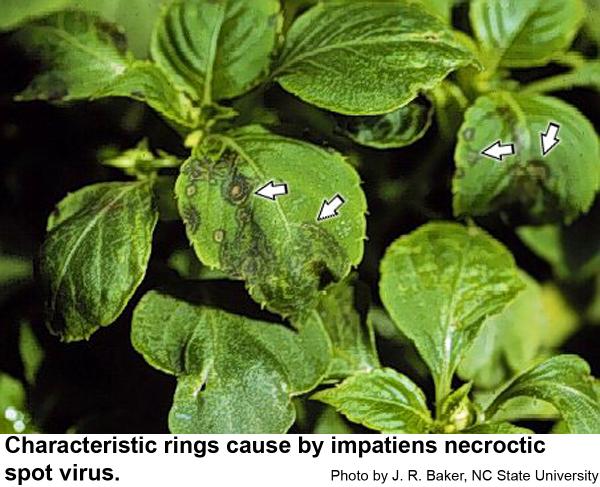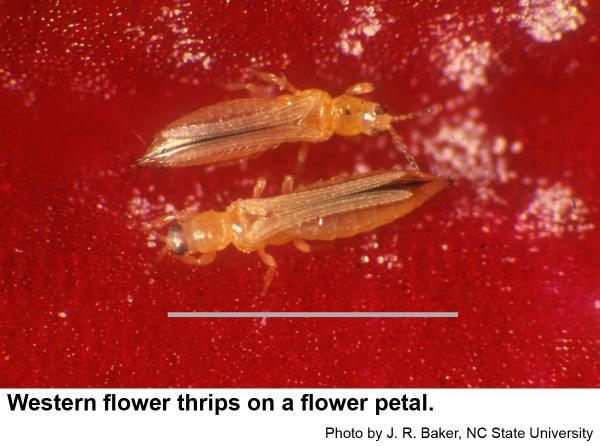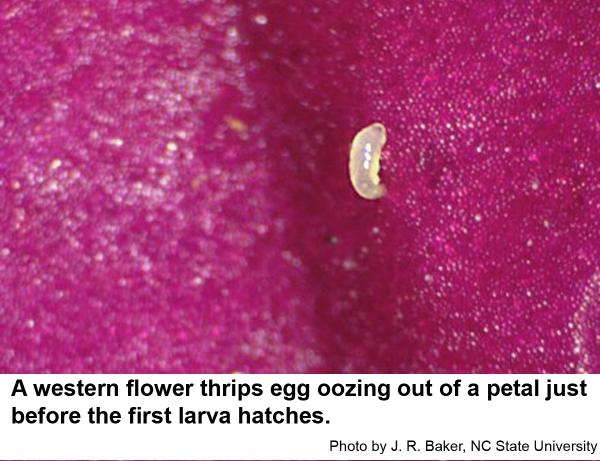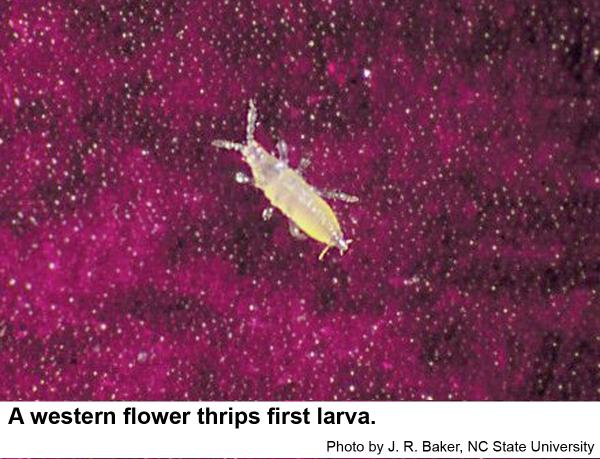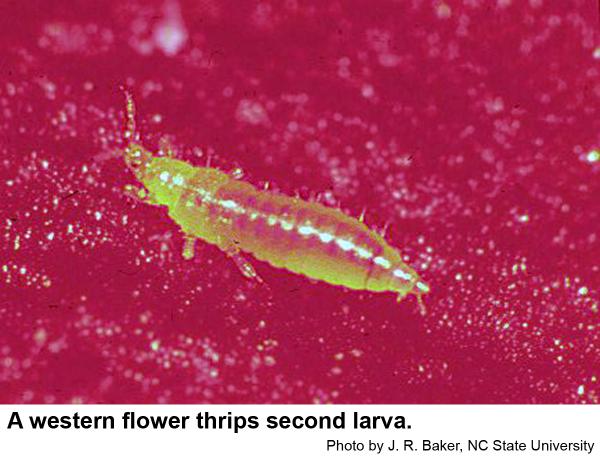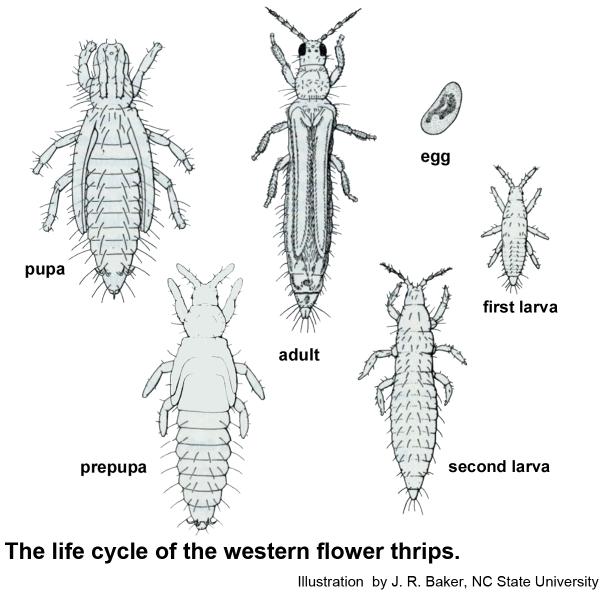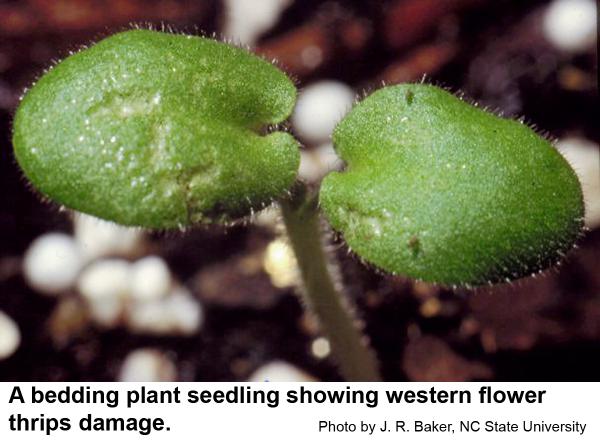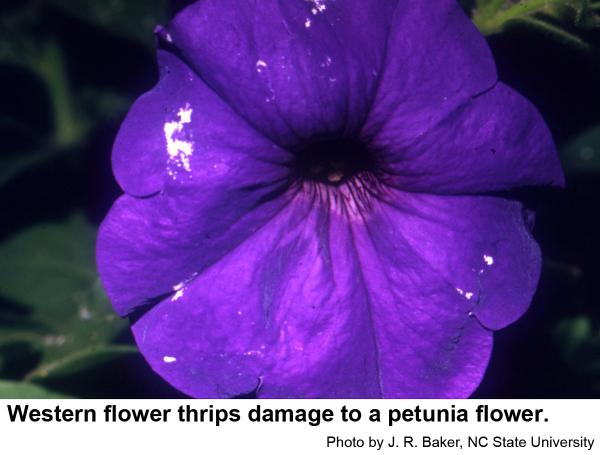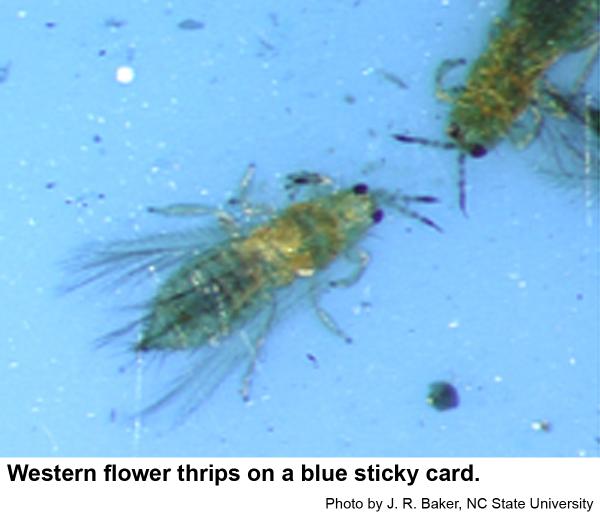General Information
Western flower thrips used to occur only in the western United States and Canada. It is now widespread and the most serious pest of greenhouse floricultural crops in much of the world. Western flower thrips damage plants directly by feeding on leaf and flower tissue. However, they may also transmit tomato spotted wilt virus (TSWV) and impatiens necrotic spot virus (INSV). Greenhouse losses due to impatiens necrotic spot virus have been severe. The combination of thrips damage and this virus can cause serious economic loss for flower growers.
Female western flower thrips are small, slender, winged insects which are amber or yellowish-brown to dark brown in color. The wings have microscopic fringes of setae. Females are about 1⁄16 long. Males are similar to females but smaller and always light yellow.
Biology
Western flower thrips and thrips, in general, have six developmental stages: egg, two larval stages, prepupae, pupae, and adult. Western flower thrips females can lay 150 to 300 eggs in her lifetime. Eggs are delicate, cylindrical, slightly kidney-shaped, smooth and translucent white. These are inserted into leaf, bract, or petal tissue and very difficult to detect. First stage larvae are very tiny, almost worm-like insects that are translucent white. Second stage larvae are also translucent white, but are similar to the adult in size and shape. They crawl and jump quickly on the surface of leaves. Both instars have red eyes. Prepupae are similar to second stage larvae except that the wing buds are externally visible. Western flower thrips pupate in flowers or in soil. Pupae do not feed and have longer wing buds and the antennae are folded back over the head. At 86 degrees F, development from egg to adult takes 13 days or less. Adults live about 28 days.
Western flower thrips feed on hundreds of plant species. These include weeds, grasses, fruit, vegetable, and field crops, and most if not all ornamental plants. Ornamental greenhouse crops typically damaged by thrips include gerbera, chrysanthemum, gladiolus, gloxinia, and rose. However, most cut flower, foliage, bedding plant, and propagation material grown in greenhouses is susceptible.
Western flower thrips have a single mandible they use to scrape and puncture plant tissue. They feed on sap that seeps from the wounds. They also consume pollen and spend much of their time in flower heads, if available. In flowers, thrips feed on pollen and on the petals. Feeding on the petals causes pale spots and necrotic patches so that infested blossoms age prematurely.
Feeding on young foliage by this pest results in distorted growth as the leaf tissue expands. Damaged leaves may be puckered and twisted. Feeding on expanded tissue forms pale spots as the thrips slash the surface of the leaf and suck out the contents of the cells beneath.
Larvae of the western flower thrips can become infected with tomato spotted wilt virus (TSWV) or impatiens necrotic spot virus (INSV) by feeding on an infected plant for only 30 minutes. After a latent period of 3 to 18 days, these thrips can then infect new plants after feeding only 5 to 15 minutes. Only larvae can become infected by these viruses. However, since adults can fly from host to host adults do most transmission of the disease.
Monitoring
Leaf stippling and distortion are good indications of thrips feeding. Western flower thrips also leaves specks of black feces on the surface of leaves and flowers. Damage is often noticed by growers before the insect is detected. However, at this point thrips populations are probably very high and have caused irreparable damage to plants. They may also have infected plants with INSV or other viruses. Therefore, it is important to monitor for thrips themselves rather than wait for damage to appear.
Western flower thrips abundance can be monitored with yellow sticky cards although blue is generally more attractive to thrips and less attractive to other insects. Yellow sticky cards should be placed throughout a greenhouse on stakes so they are just above the crop canopy. Move cards up as canopy height increases.
Visual inspection of plants is another easy way to detect thrips. Look on the underside of leaves for the fast moving larvae and fecal matter. Tap flower heads onto a sheet of paper and look for thrips that are dislodged.
Indicator plants can also be useful to monitor for thrips and tospoviruses such as INSV. Indicator plants are species that are more attractive and susceptible to thrips and tospoviruses than the production plant. Since it is more attractive and susceptible, the indicator plant will attract thrips and show symptoms of feeding and virus infection before the crop. This provides an early warning to growers of a developing thrips population.
Petunia plants make good plants to indicate the presence of western flower thrips feeding. In addition, petunias have a hyper-sensitive response to tospovirus infection resulting in rapid, visible death of tissue around the infection site. This provides a visual cue for growers that infected thrips are present in the greenhouse.
Decision Making
Since thrips feeding causes leaf and flower discoloration and distortion as well as infection by terminal viruses, tolerance for thrips is quite low. Reliable thresholds are not available because crops vary in their attractiveness and sensitivity to thrips feeding. Further, greenhouse temperature will affect development time and thus the time between thrips detection and overwhelming populations. Keeping records of thrips captures on sticky cards at different times of year and in different crops will help growers determine when treatment is necessary. If INSV or other tospovirus such as TSWV is detected with indicator plants or commercial testing kits, thrips should be treated immediately.
Control & Intervention
The western flower thrips breeds successfully in many greenhouses all year long. Therefore, the same population is exposed to insecticides repeatedly through the year. This is one reason western flower thrips has developed resistance to many insecticides. In addition, systemic insecticides do not provide complete control because they do not translocate well to flower buds, petals, and pollen where thrips do much of their feeding. Therefore, insecticides must kill on contact. This presents another problem because thrips wedge down deep into blossoms, buds and other hard to reach places and thus avoid contact with the pesticide. These issues make thrips difficult to control.
Cultural control. Greenhouse sanitation is essential for thrips management. Thrips will reproduce on weeds that are present in greenhouses. Weeds also serve as a reservoir for tospoviruses and other pests. Thrips can pupate in potting soil or other debris on the floor and benches. Denying these resources can help interrupt the lifecycle of western flower thrips and reduce the rate of population growth. Keep grass and flowering weeds outside the greenhouse mowed short, also. If there are multiple greenhouses, workers should avoid yellow or bright colored clothing, or provide them with lab coats to switch out when moving from one greenhouse to another. In high risk or high value areas, a vestibule, outside "chamber" could be built through which to pass first before entering the greenhouse itself.
Perhaps the best way to manage western flower thrips is to prevent them from entering greenhouses in the first place. This requires the use of thrips screen over fans, vents, and other openings. It also helps to quarantine and inspect new plant material before moving it into the greenhouse with existing plants.
Biological control. A number of biological control agents are available for managing thrips. These include predacious mites (Neoseilus cucmeris and N. degenerans), minute pirate bug (Orius insidiosus), entomopathogenic fungi, and nematodes. Biological control of thrips can be implemented successfully. However, it must be part of a well planned IPM or biological control program that includes, scouting, monitoring, and use of insecticides that are compatible with natural enemies.
Chemical control. Conserve (spinosad) is currently an effective chemical registered against western flower thrips. It is also the most widely used, which sets up potential for resistance. Other insecticides labeled for thrips management in ornamental greenhouse crops are listed in Table 1. Many of these such as pyrethroids and orthene are more lethal to beneficial insects and mites than other available products. They are therefore not compatible with biological control programs. In order to impede the onset of resistance to insecticides, it is essential that growers use several insecticides from different IRAC Mode of Action groups rather than using the same pesticide time after time. Pesticides will kill active stages of thrips that they contact but will not kill eggs or pupae. Just days after a pesticide application new larvae and adults will emerge. Therefore, a second application is recommended 3-7 days later. If a greenhouse contains mixed plant materials, all plants may need to be treated, not just the severely infested ones, to avoid having thrips jump from one type of plant to another and back again.
| Active Ingredient | Trade Name | Thrips Stage Affected | Signal Word | IRAC MOA Group | Compatible with Beneficials |
|---|---|---|---|---|---|
| abamectin | Avid* | L, A | Caution | 6 | Yes |
| acephate | Orthene | L, A | Caution | 1B | No |
| acetamprid | TriStar | L, A | Caution | 4A | Yes |
| azadirachtin | Azatin | L | Caution | 18B | Yes |
| bifenthrin | Talstar | L, A | Caution | 3 | No |
| cyfluthrin | Decathlon | L, A | Caution | 3 | No |
| fenpropathrin | Tame | L, A | Caution | 3 | No |
| horticultural oil | many | L, A | Warning | - | Yes |
| kinoprene | Enstar II | L | Warning | 7A | Yes |
| novaluron | Pedestal | L | Caution | 15 | Yes |
| spinosad | Conserve | L, A | Caution | 5 | Yes |
|
L = larva, A= adult When used as directed, pyrethroids are very toxic to insects but are not particularly hazardous to humans and pets (other than fish—avoid using pyrethroids around pools, ponds, and streams). |
|||||
The latest and more complete set of pesticide choices can be found in the North Carolina Agricultural Chemicals Manual under "thrips." Unfortunately, control of the western flower thrips is likely to be difficult and costly in the foreseeable future.
Recommendations of specific chemicals are based upon information on the manufacturer's label and performance in a limited number of trials. Because environmental conditions and methods of application by growers may vary widely, performance of the chemical will not always conform to the safety and pest control standards indicated by experimental data.
Other Resources
- Insects Found on Yellow Sticky Traps in the Greenhouse. Frank, S. 2018. NC State Extension Entomology Insect Notes.
- Insect Screening for Greenhouses. Frank, S. et al. 2018 (revised). NC State Extension Entomology Insect Notes.
- Managing Diseases. Thiessen, L. 2018. Flue-Cured Information, Chapter 8. Department of Crop & Soil Sciences. NC State Extension.
- Western Flower Thrips in Greenhouses: A Review of its Biological Control and Other Methods. Van Driesche, R. No Date. Applied Biological Control Research, UCRiverside.
- NC State Extension Plant Pathology Publications
- NC State Horticultural Science Publications
- North Carolina Agricultural Chemicals Manual
For assistance with a specific problem, contact your local Cooperative Extension center.
Publication date: July 1, 2009
Reviewed/Revised: Nov. 13, 2020
Recommendations for the use of agricultural chemicals are included in this publication as a convenience to the reader. The use of brand names and any mention or listing of commercial products or services in this publication does not imply endorsement by NC State University or N.C. A&T State University nor discrimination against similar products or services not mentioned. Individuals who use agricultural chemicals are responsible for ensuring that the intended use complies with current regulations and conforms to the product label. Be sure to obtain current information about usage regulations and examine a current product label before applying any chemical. For assistance, contact your local N.C. Cooperative Extension county center.
N.C. Cooperative Extension prohibits discrimination and harassment regardless of age, color, disability, family and marital status, gender identity, national origin, political beliefs, race, religion, sex (including pregnancy), sexual orientation and veteran status.

